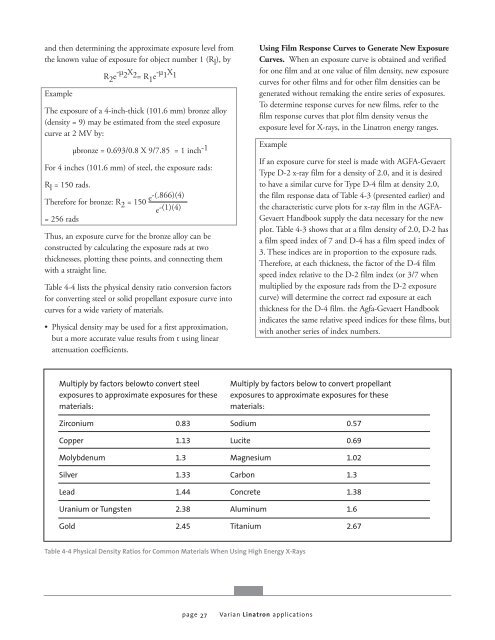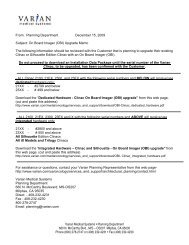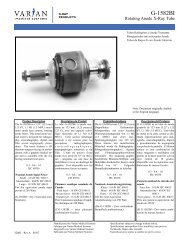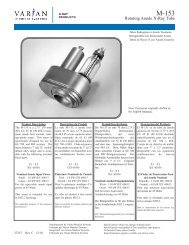Varian Linatron High-Energy X-ray Applications 2007
Varian Linatron High-Energy X-ray Applications 2007
Varian Linatron High-Energy X-ray Applications 2007
Create successful ePaper yourself
Turn your PDF publications into a flip-book with our unique Google optimized e-Paper software.
and then determining the approximate exposure level from<br />
the known value of exposure for object number 1 (Rl ), by<br />
R2e -μ2X2= R1e -μ1X1 Example<br />
The exposure of a 4-inch-thick (101.6 mm) bronze alloy<br />
(density = 9) may be estimated from the steel exposure<br />
curve at 2 MV by:<br />
μbronze = 0.693/0.8 X 9/7.85 = 1 inch-1 For 4 inches (101.6 mm) of steel, the exposure rads:<br />
R l = 150 rads.<br />
Therefore for bronze: R2 = 150 e-(.866)(4)<br />
e<br />
= 256 rads<br />
-(1)(4)<br />
Thus, an exposure curve for the bronze alloy can be<br />
constructed by calculating the exposure rads at two<br />
thicknesses, plotting these points, and connecting them<br />
with a straight line.<br />
Table 4-4 lists the physical density ratio conversion factors<br />
for converting steel or solid propellant exposure curve into<br />
curves for a wide variety of materials.<br />
• Physical density may be used for a first approximation,<br />
but a more accurate value results from t using linear<br />
attenuation coefficients.<br />
Multiply by factors belowto convert steel<br />
exposures to approximate exposures for these<br />
materials:<br />
Zirconium 0.83<br />
Copper 1.13<br />
Molybdenum 1.3<br />
Silver 1.33<br />
Lead 1.44<br />
Uranium or Tungsten 2.38<br />
Gold 2.45<br />
page 27<br />
Using Film Response Curves to Generate New Exposure<br />
Curves. When an exposure curve is obtained and verified<br />
for one film and at one value of film density, new exposure<br />
curves for other films and for other film densities can be<br />
generated without remaking the entire series of exposures.<br />
To determine response curves for new films, refer to the<br />
film response curves that plot film density versus the<br />
exposure level for X-<strong>ray</strong>s, in the <strong>Linatron</strong> energy ranges.<br />
Example<br />
Table 4-4 Physical Density Ratios for Common Materials When Using <strong>High</strong> <strong>Energy</strong> X-Rays<br />
If an exposure curve for steel is made with AGFA-Gevaert<br />
Type D-2 x-<strong>ray</strong> film for a density of 2.0, and it is desired<br />
to have a similar curve for Type D-4 film at density 2.0,<br />
the film response data of Table 4-3 (presented earlier) and<br />
the characteristic curve plots for x-<strong>ray</strong> film in the AGFA-<br />
Gevaert Handbook supply the data necessary for the new<br />
plot. Table 4-3 shows that at a film density of 2.0, D-2 has<br />
a film speed index of 7 and D-4 has a film speed index of<br />
3. These indices are in proportion to the exposure rads.<br />
Therefore, at each thickness, the factor of the D-4 film<br />
speed index relative to the D-2 film index (or 3/7 when<br />
multiplied by the exposure rads from the D-2 exposure<br />
curve) will determine the correct rad exposure at each<br />
thickness for the D-4 film. the Agfa-Gevaert Handbook<br />
indicates the same relative speed indices for these films, but<br />
with another series of index numbers.<br />
Multiply by factors below to convert propellant<br />
exposures to approximate exposures for these<br />
materials:<br />
Sodium 0.57<br />
Lucite 0.69<br />
Magnesium 1.02<br />
Carbon 1.3<br />
Concrete 1.38<br />
Aluminum 1.6<br />
Titanium 2.67<br />
<strong>Varian</strong> <strong>Linatron</strong> applications











![[MSDS 126] Dow Corning 200 Fluid, 5 CST Part Number ... - Varian](https://img.yumpu.com/5104917/1/190x245/msds-126-dow-corning-200-fluid-5-cst-part-number-varian.jpg?quality=85)





